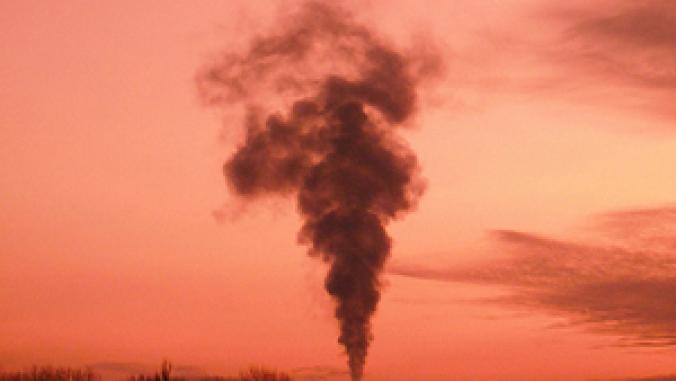Carbon Capture Faces Big Hurdles in Climate Fight: Report
A new study from the World Resources Institute looks at what changes will be required from industry and government will be needed to make coal-fired power plants a feature of a low-carbon future and finds significant, although not insurmountable, obstacles to success.
As a cheap and relatively plentiful source of power for some of the world's largest economies, many millions of people have a vested interest in finding ways to keep coal in the mix of our future energy supplies. But until utilities and energy companies can develop a way to reduce the significant greenhouse gases generated by coal-fired power plants, coal's future is often seen as incompatible with the world's low-carbon future.
According to a new report from the World Resources Institute, despite widespread hope and discussion of carbon capture and sequestration (CCS) as a means to green up coal, there is a long road ahead, filled with challenges on both the policy and innovation fronts, to achieve that goal.
The report, "Capturing King Coal," explores the current state of CCS research and analyzes the complex challenges faced by investors when deploying CCS technologies. The report's authors -- Hiranya Fernando, John Venezia, Clay Rigdon, and Preeti Verma -- find that until government policies support large-scale demonstrations, CCS is unlikely to fulfill its potential in combating climate change.
"Capturing King Coal" cites as one example of the uphill battle CCS faces the collapse of the Department of Energy's FutureGen plant -- a project intended to highlight the potential of CCS as a near-term solution, but one that fell to pieces in the wake of dramatic cost overruns and public opposition.
Among the many technical, regulatory and financial challenges CCS projects face, according to the report, are the complex nature of the technologies involved -- not just a single innovation, but a slew of different technologies make up any CCS system; major shifts in government policy and funding to encourage development of these technologies; market-based systems including a price on carbon emissions that make investing in CCS development a viable strategy; ensuring that long-term storage is technologically feasible and that liability for any leakages decades or centuries into the future are clearly outlined; and finally, and perhaps among the most significant hurdles, is overcoming public resistance to coal-fired power plants and the environmental destruction resulting from modern coal-mining methods.
"Unless we can put a price on carbon and push these new technologies into the market with additional incentives CCS won't arrive in time," said Dr. Jonathan Pershing, director of WRI’s climate, energy and pollution program. "We need to deploy the technology as quickly as possible -- and that in turn means paying for large scale demonstrations and infrastructure, and creating a regulatory environment that provides public confidence in the safety and environmental integrity of the technology."
The full report, "Capturing King Coal: Deploying Carbon Capture and Storage Systems in the U.S. at Scale," is available for download from ClimateBiz.com. More information from the World Resources Institute is online at http://wri.org.
According to a new report from the World Resources Institute, despite widespread hope and discussion of carbon capture and sequestration (CCS) as a means to green up coal, there is a long road ahead, filled with challenges on both the policy and innovation fronts, to achieve that goal.
The report, "Capturing King Coal," explores the current state of CCS research and analyzes the complex challenges faced by investors when deploying CCS technologies. The report's authors -- Hiranya Fernando, John Venezia, Clay Rigdon, and Preeti Verma -- find that until government policies support large-scale demonstrations, CCS is unlikely to fulfill its potential in combating climate change.
"Capturing King Coal" cites as one example of the uphill battle CCS faces the collapse of the Department of Energy's FutureGen plant -- a project intended to highlight the potential of CCS as a near-term solution, but one that fell to pieces in the wake of dramatic cost overruns and public opposition.
Among the many technical, regulatory and financial challenges CCS projects face, according to the report, are the complex nature of the technologies involved -- not just a single innovation, but a slew of different technologies make up any CCS system; major shifts in government policy and funding to encourage development of these technologies; market-based systems including a price on carbon emissions that make investing in CCS development a viable strategy; ensuring that long-term storage is technologically feasible and that liability for any leakages decades or centuries into the future are clearly outlined; and finally, and perhaps among the most significant hurdles, is overcoming public resistance to coal-fired power plants and the environmental destruction resulting from modern coal-mining methods.
"Unless we can put a price on carbon and push these new technologies into the market with additional incentives CCS won't arrive in time," said Dr. Jonathan Pershing, director of WRI’s climate, energy and pollution program. "We need to deploy the technology as quickly as possible -- and that in turn means paying for large scale demonstrations and infrastructure, and creating a regulatory environment that provides public confidence in the safety and environmental integrity of the technology."
The full report, "Capturing King Coal: Deploying Carbon Capture and Storage Systems in the U.S. at Scale," is available for download from ClimateBiz.com. More information from the World Resources Institute is online at http://wri.org.




